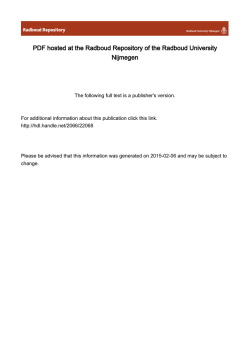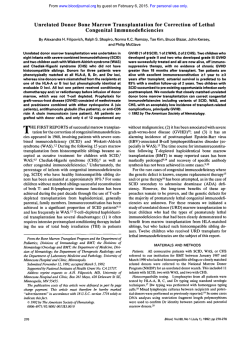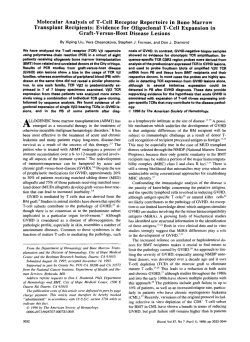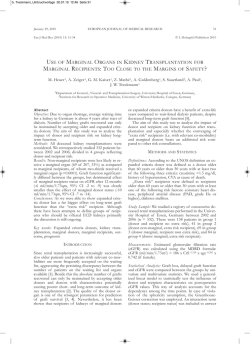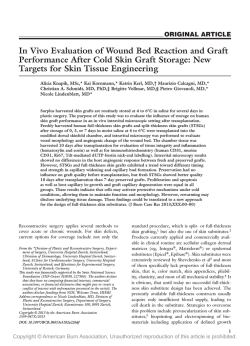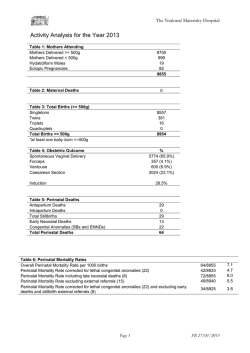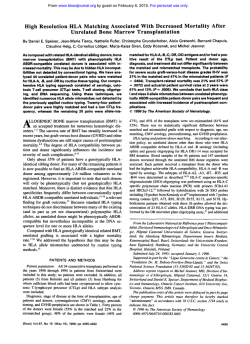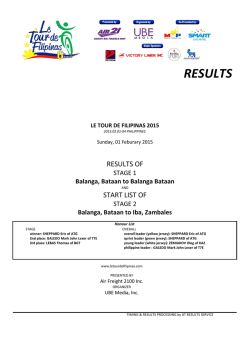
Comparing two types of rabbit ATG prior to reduced intensity
1 2 3 4 5 6 7 8 9 10 11 12 13 14 15 Comparing two types of rabbit ATG prior to reduced intensity conditioning allogeneic hematopoietic SCT for hematologic malignancies Sandra Paiano, Eddy Roosnek, Yordanka Tirefort, Monika Nagy -Hulliger, Stavroula Masouridi, Emmanuel Levrat, Michael Bernimoulin, Saadia Huguet, Alessandro Casini, Thomas Matthes, Kaveh Samii, Jakob R. Passweg, Y ves Chalandon Division of Hematology, Geneva University Hospital and University of Geneva, Geneva, Switzerland 16 17 18 19 20 21 22 23 24 25 26 27 28 29 Correspondence to: Pr. Y.Chalandon Hematology Service, University Hospital of Geneva, 4 rue Gabrielle-Perret-Gentil 1205 Geneva 14, Switzerland e-mail: [email protected] 1 30 ABSTRACT 31 Different rabbit polyclonal anti-lymphocyte globulins (ATG) are used in allogeneic 32 hematopoietic stem cell transplantation (alloHSCT) to prevent graft-versus-host 33 disease (GvHD). We compared 2 different ATG in alloHSCT after reduced intensity 34 conditioning (RIC) for hematological malignancies. We reviewed 30 alloHSCT for 35 hematologic malignancies performed between 2007 and 2010 with fludarabine and 36 i.v. busulfan as conditioning regimen. Patients alternatingly received Thymoglobulin® 37 or ATG-F®. Median follow up was 3.3 (2.5-4.5) years. Adverse events appeared to 38 occur more frequently during Thymoglobulin® infusion than during ATG-F® infusion 39 but without statistical significance (p=0.14). There were also no differences in 3-year 40 overall survival (OS), disease free survival (DFS), relapse incidence and transplant 41 related mortality (TRM) in the Thymoglobulin® vs ATG-F® group: 45.7% vs 46.7%, 42 40% vs 33.7%, 40% vs 33.3%, 20% vs 33.3%. The same held for graft failure, 43 rejection, infectious complications, immune reconstitution and acute or chronic 44 GvHD. In patients transplanted for hematologic malignancies after RIC, the use of 45 Thymoglobulin® is comparable to that of ATG-F® in all the aspects evaluated in the 46 study. However due to the small number of patients in each group we can’t 47 exclude a possible difference that may exist. 48 49 KEYWORDS: ATG, RIC, alloHSCT, hematological malignancies 50 2 51 INTRODUCTION 52 Anti-thymocyte globulins (ATG) are used as immunomodulatory agents for prevention 53 and treatment of graft versus host disease (GvHD) (1) in allogeneic hematopoietic 54 stem cell transplantation (alloHSCT), for prevention and treatment of solid organ graft 55 rejection, for treatment of aplastic anemia and occasionally for treatment of other 56 autoimmune disorders (2,3). These polyclonal immunoglobulins are IgG preparations 57 from rabbits immunized with human thymocytes (Thymoglobulin®) or with the T-acute 58 lymphoblastic leukemia cell line Jurkat (ATG-Fresenius®, ATG-F®) (4). ATG depletes 59 T lymphocytes by induction of apoptosis or complement-dependent lysis. 60 Furthermore, it may add immune suppression by modulation of surface molecules 61 mediating leukocyte/endothelium interactions , induction of B-cell apoptosis, 62 interference with dendritic cells properties, induction of regulatory T cells or induction 63 of NK T cells (5). 64 Differences between safety and efficacy of different brands of ATG are not well 65 understood and only few studies have addressed these questions (6-9). 66 67 The aim of this analysis was to compare the impact of these two rabbit polyclonal 68 anti-lymphocyte globulins on outcome in alloHSCT after reduced intensity 69 conditioning regimen (RIC) for hematological malignancies. 70 71 3 72 PATIENTS AND METHODS 73 Our report is a retrospective study of 30 consecutive patients transplanted between 74 2007 and 2010 after RIC consisting of ATG in combination with fludarabine 30 75 mg/m2/day for 5 days and busulfan iv 3.2 mg/kg/day for 2 days, or fludarabine 30 76 mg/m2/day for 5 days and melphalan 70 mg/m2/day for 2 days (Hodgkin disease 77 patients only). In order to avoid cost containment measures, we alternated between 78 treatment with Thymoglobulin®, 2.5 mg/kg/day from day -5 to day -3 before transplant 79 and ATG-F®, 5 mg/kg/day from day -6 to day -2. Twelve patients were transplanted 80 for AML, the others for undifferentiated acute leukemia (1), lymphoma (9), multiple 81 myeloma (2), chronic myelomonocytic leukemia (3), myelodysplasic syndrome (2) or 82 myelofibrosis (1). Stem cells came from peripheral blood mononuclear cells for all 83 patients except for one patient in the ATG-F® group who received bone marrow. 84 Immunosuppression consisted of cyclosporine 4 mg/kg/day in continued infusion, 85 mycophenolate mofetil for 1 month, and methylprednisolone 1000 mg during the 2 86 days before transplantation. Sixteen patients received a graft T-cell depleted with 20 87 mg alemtuzumab in vitro, followed the next day by an infusion of 100 x106 CD3/kg for 88 related donors and 0.35 x 10 6 CD3/kg for unrelated donors (15). Median follow up 89 was 3.3 (2.5-4.5) years, with no significant difference between groups receiving 90 different ATG. We reviewed patient age, gender, diagnosis, remission status at 91 transplant, CMV serostatus, reason for RIC instead of standard conditioning, type of 92 donor, use of T-cell depletion with Campath® (alemtuzumab), T-lymphocyte add-back 93 dose, blood group compatibility and GvHD prophylaxis and found no differences 94 between the two groups (Table 1). 95 96 Outcomes 4 97 Outcomes analyzed were toxicity (incidence of adverse events during infusion of 98 ATG), graft failure, rejection, infectious complications (infectious complications 99 leading to hospitalization, intravenous antibiotherapy or antiviral treatment (excluding 100 preemptive treatment for CMV reactivation without clinical infection)) , effects on 101 immune reconstitution, acute and chronic GvHD, treatment related mortality (TRM), 102 relapse incidence and overall survival. Immune reconstitution was assessed by CD3, 103 CD4 and CD8 counts and immunoglobulin levels (IgG, IgA and IgM). 104 105 Statistical analysis 106 Appropriate parametric or nonparametric tests were used to compare groups for 107 continuous or categorical variables. Overall survival (OS) and disease free survival 108 (DFS) was estimated using the Kaplan-Meyer method (16), the log-rank test was 109 used for comparison. Cumulative incidence was used for relapse, TRM and GvHD. 110 Relapse was used as competing risk for TRM incidence and also for GvHD 111 incidence. 112 113 5 114 RESULTS 115 Toxicity 116 There was a tendency to a higher incidence of adverse events during the 117 Thymoglobulin® perfusion compared to ATG-F®, p=0.14 (Table 2). Chills and / or 118 fever occurred in 7 patients (2 patients had fever, 2 had chills, 2 had fever and chills 119 including 1 with arterial hypotension, 1 had fever with osteoarticular pain), and acute 120 hepatic cytolysis in one patient in the Thymoglobulin® group. In the ATG-F® group, 121 osteoarticular pain occurred during 2 infusions, fever and chills during one and chills 122 during another infusion. 123 124 Graft Take/rejection 125 Time to engraftment was similar in both group, with neutrophils reaching > 0.5 G/L at 126 a median time of 17 days (7-21) in the ATG-F® group and 17.5 days (11-22) in the 127 Thymoglobulin® group (p = 0.60). Neutrophils reached levels above 1.5 G/L at a 128 median time of 19 days (10-22) in the ATG-F® group and 18 days (12-24) in the 129 Thymoglobulin® group (p = 0.76). Thrombocytes reached levels above 20 G/L at a 130 median of 8.5 days (0-25) in the ATG-F® group and 10 days (0-85) in the 131 Thymoglobulin® group (p = 0.46) and were at 50 G/L at a median time of 13 days (0- 132 35) in the ATG-F® group and 12 days (0-40) in the Thymoglobulin® group (p = 0.52). 133 There was one graft failure in each group (Table 2). Two rejections occurred in the 134 ATG-F® group and 3 in the Thymoglobulin® group with similar median times to 135 rejection (ATG-F® group, 48 days, range 39-57; Thymoglobulin®, 39 days, range 28- 136 72, p = 0.93). 137 138 Infections 6 139 The number of patients suffering from severe infections after the period of aplasia in 140 the two groups were similar (9 in the ATG-F® group and 7 in the Thymoglobulin® 141 group, p = 0.46) (Table 2). They consisted mainly of respiratory tract infections and 142 bacteremia and some patients suffered from more than one. CMV viremia 143 reactivation occurred in 11 patients in the ATG-F group and in 10 in the 144 Thymoglobulin group, p = 0.69 (Table 2). Owed to the preemptive treatment with 145 gancyclovir or valganciclovir, no clinical infection occurred. 146 147 Immune reconstitution 148 We measured immune reconstitution by the number of CD4- and CD8-positive T cells 149 and by dosage of serum immunoglobulins. At 1 year post-transplantation, the number 150 of CD4-positive T cells reached > 200/ul in 3 patients treated with ATG-F and in 5 151 treated with Thymoglobulin (p = 1.00), > 400/ul in 0 and 2 patients in the respective 152 groups (p = 0.18). CD8 counts > 300/ul was reached in 6 and 5 patients, respectively 153 (p = 1.00). Eight patients in the ATG-F group and 7 patients in the Thymoglobulin® 154 group had an IgG level > 5 g/l (p = 1.00) while the level of IgG, IgA and IgM was 155 normal in 5 and 4 patients, respectively (p = 1.00). 156 157 158 GvHD 159 The cumulative incidence of acute GvHD (aGvHD) grade I-IV at day 100 was twice 160 as high (53.3%, 95% CI 33.2-85.6%) in the ATG-F® group as in the Thymoglobulin® 161 group (26.7%, 95% CI 11.5-61.7%) but this difference did not reach statistical 162 significance, p=0.23 (Table 2, Figure 1). Two GvHD grade I and 6 GvHD grade II 163 occurred in the ATG-F® group and 2 GvHD grade I, 1 grade II, 1 GVHD grade III and 164 1 grade IV in the Thymoglobulin® group. The cumulative incidence of mainly 7 165 extensive chronic GvHD, at 3 year was 13.3% (95% CI 3.7-48.5%) in the ATG-F® 166 group and 20.0% (95% CI 7.3-55.0%) in the Thymoglobulin® group, p=0.87 (Table 2). 167 168 169 OS, DFS, TRM and relapse 170 OS and DFS at 3 years were 46.4% (95% CI 28.4-64.4% ) and 36.7% (95% CI 19.1- 171 54.3% ) respectively (Fig 2 A-B), without statistical differences between both 172 groups. Three years OS was 45.7 (95% CI 19.7- 71.7% ) and 46.7 (95% CI 20.7- 173 72.7% ), p=0.97, 3 years DFS was 40.0 (95% CI 14.8- 65.2% ) and 33.7 (95% CI 8.9- 174 58.1% ), p=0.86, in the Thymoglobulin ® and ATG-F® groups respectively (Fig 2 C- 175 D). 176 177 We observed tendencies to a lower TRM and more relapses in the 178 Thymoglobulin® group but this did not reach statistical significance. 179 Cumulative incidence of TRM at 3 years was 33.3% , 95% CI 16.3-68.2% in the 180 ATG-F® group and 20% , 95% CI 7.3-55% in the Thymoglobulin ® group, p=0.67 181 (Table 2). Cause of death was infection (3 in each group), relapse (3 in the ATG- 182 F® group and 4 in the Thymoglobulin ® group), GvHD (1 in each group) or 183 hemorrhage (1 in the ATG-F® group). The cumulative incidence of relapse at 184 three years (ATG-F® group 33.3% , 95% CI 16.3-68.2% and Thymoglobulin ® 185 group 40% , 95% CI 21.5-74.3% ) was not statistically different, p=0.55 (Table 2). 186 8 187 DISCUSSION 188 We have analyzed the outcome of two different rabbit polyclonal anti-lymphocyte 189 globulins in alloHSCT after RIC for hematological malignancies. 190 In our small cohort of 30 patients, we did not find any statistically significant 191 differences between the two groups regarding all parameters tested (i.e. 192 toxicity, engraftment, infection rate, immune reconstitution, GvHD incidence, 193 TRM or DFS). Given the small groups analyzed, it is not possible to see if there 194 are differences, even if there were some. However, tendency towards more 195 relapse, less TRM and less acute GvHD was noticed in the Thymoglobulin® 196 group. This may point to a more T-cell depleting potential in the doses used. 197 Nevertheless, given the non significant differences, the results should not be 198 overinterpreted. 199 200 To our knowledge, our study is the first to compare these two ATG in alloHSCT for 201 patients suffering from hematological malignancies. A single center retrospective 202 Japanese study (6) comprising 3 patients receiving Thymoglobulin® (2.5 mg/kg/day 203 from day -5 to day -2 before transplant) and 4 receiving ATG-F® (5 mg/kg/day from 204 day -7 to day -3 before transplant) has compared these ATG’s in alloHSCT for 205 aplastic anemia. They noticed no acute GvHD grade II nor rejection, but they 206 observed CMV reactivation in 3 / 3 patients who had received Thymoglobulin® and in 207 2 / 4 of the ATG-F® group. CD4 and CD8 lymphocytes recovered later in the 208 Thymoglobulin® group than in the ATG-F® group (data based on values on day 60). 209 These results suggested that Thymoglobulin® had a stronger immunosuppressive 210 effect than ATG-F® . In our study, we confirmed these high rates of CMV reactivation, 211 (10/15 in the Thymoglobulin® and 11/15 in the ATG-F® group) but we did not see a 212 difference in CD4 and CD8 lymphocyte recovery at one year. 9 213 214 ATG is used to prevent rejection after solid organ transplantation. Also here, some 215 studies have reported a possible more immunosuppressive effect of Thymoglobulin®. 216 In a single-center retrospective French study published in 2004, comprising 194 renal 217 transplanted patients (7), 65 of whom received Thymoglobulin® (2-5 mg/kg day 0 and 218 1-2 mg/kg days 1 to 4 post-transplant) and 129 ATG-F® (9 mg/kg day 0 and 3 mg/kg 219 days 1 to 4 post-graft), more CMV reactivation occurred in the Thymoglobulin® than 220 in the ATG-F® group (37% versus 23%, p=0.02). Furthermore, in the Thymoglobulin® 221 group more patients developed post-transplant malignancies (12.3 % versus 3.9%, 222 p=0.01) and/or died (13.8 versus 3.9%, p=0.005). An Italian single center prospective 223 randomized trial in heart transplantation (8) with 20 patients in the Thymoglobulin® 224 group (2.5 mg/kg/day for 5 days post-transplant) and 20 in ATG-F® group (2.5 225 mg/kg/day for 7 days post-transplant) found no difference in rejection and survival, 226 but more CMV reactivations in the Thymoglobulin® group (65% versus 30%, p= 227 0.002). Furthermore new CMV infections occurred only in the Thymoglobulin® group 228 (20%, p=0.05). No secondary malignancies were observed (follow up of 32.8 +/- 8.9 229 months). By contrast, a Swiss single center prospective randomized study from 2002 230 (9) comparing Thymoglobulin® 2.5 mg/kg days 1 to 5 post-transplant (n=26) and 231 ATG-F® 3-3.5 mg/kg days 1 to 5 post-transplant (n=24) in the induction treatment for 232 heart transplantation found no difference in survival, acute rejection or infection rate, 233 for patients followed one year. 234 235 A more immunosuppressive effect of Thymoglobulin® may be owed to a more 236 efficient depletion of T cells. Twenty years ago, different preparations of horse and 237 rabbit ATG have been compared (10), including Thymoglobulin® and ATG-F® and the 238 latter appeared to bind somewhat less efficiently to many of the surface antigens on 10 239 T cells. However, another study showed no difference in T cell cytotoxicity of 240 Thymoglobulin® and ATG-F® (11). Hence, differences will be relatively small, also 241 because the effective doses of both ATG’s have been titrated to calibrate the risk of 242 infection and taking the benefit against GvHD and graft failure (12-14). 243 244 CONCLUSIONS 245 In conclusion, subject to the small groups analyzed, our study does not show any 246 statistically significant differences between Thymogobulin® and ATG-F® 247 regarding all the parameters tested. It may therefore be worthwhile to compare 248 more in depth this two anti-lymphocyte globulins, in a larger study, to ascertain 249 that the tendency to some difference shown in the literature is real or not. 250 However due to the small number of patients in each group we can’t exclude a 251 possible difference that may exist. In fact, if there are some, the choice of the 252 product should be based on the specific properties of each one and so adapted 253 to the patient risk status. 254 11 255 ACKNOWLEDGMENTS 256 We acknowledge the contribution of the medical and nursing staff of the 5FL+ ward 257 of the Hematology Division and the medical day care unit of the Oncology Division of 258 Geneva University Hospital. We also thank Corinne Charrin, Colette Grand and 259 Carole Danti n for excellent technical assistance in the stem cell laboratory. 260 261 12 262 CONFLICT OF INTEREST 263 The authors declare that there is no conflict of interests regarding the publication of 264 this paper. 265 266 267 Author contribution: 268 SP, JRP, YC designed the study. YT, MNH, SM, EL, MB, SH, AC, TM, KS, ER 269 contributed data and reviewed the manuscript. SP, JRP, YC analyzed the data. SP, 270 JRP, ER, YC wrote the manuscript. 271 13 272 REFERENCES 273 1. Theurich S, Fischmann H, Chakupurakal G, Shimabukuro-Vornhagen A, 274 Chemnitz JM, Holtick U, Rothe A, Scheid C, Hallek M, Skoetz N, von Bergwelt- 275 Baildon M. Anti-thymocyte globulins for post-transplant graft-versus-host disease 276 prophylaxis-A systematic review and meta-analysis. Crit Rev Oncol Hematol 277 2013; 88:178-186. . 278 2. Gaber AO, Monaco AP, Russell JA, Lebranchu Y, Mohty M. Rabbit antithymocyte 279 globulin (thymoglobulin): 25 years and new frontiers in solid organ transplantation 280 and haematology. Drugs 2010; 70:691-732. 281 3. Lytton SD, Denton CP, Nutzenberger AM. Treatment of autoimmune disease with 282 rabbit anti-T lymphocyte globulin: clinical efficacy and potential mechanisms of 283 action. Ann N Y Acad Sci 2007; 1110:285-296. 284 4. Popow I, Leitner J, Majdic O, Kovarik JJ, Saemann MD, Zlabinger GJ, 285 Steinberger P. Assessment of batch to batch variation in polyclonal antithymocyte 286 globulin preparations. Transplantation 2012; 93:32-40. 287 288 289 5. Mohty M. Mechanisms of action of antithymocyte globulin: T-cell depletion and beyond. Leukemia 2007; 21 :1387-1394. 6. Terasako K, Sato K, Sato M, Kimura S, Nakasone H, Okuda S, Kako S, Tanaka 290 Y, Yamazaki R, Oshima K, Tanihara A, Higuchi T, Nishida J, Kanda Y. The effect 291 of different ATG preparations on immune recovery after allogeneic hematopoi etic 292 stem cell transplantation for severe aplastic anemia. Hematology 2010; 15:165- 293 169. 294 7. Ducloux D, Kazory A, Challier B, Coutet J, Bresson-Vautrin C, Motte G , Thalamy 295 B, Rebibou JM, Chalopin JM. Long-term toxicity of antithymocyte globulin 296 induction may vary with choice of agent: a single-center retrospective study. 297 Transplantation 2004; 77:1029-1033. 14 298 8. De Santo LS, Della Corte A, Romano G, Amarelli C, Onorati F, Torella M, De Feo 299 M, Marra C, Maiello C, Giannolo B, Casillo R, Ragone E, Grimaldi M, Utili R, 300 Cotrufo M. Midterm results of a prospective randomized comparison of two 301 different rabbit-antithymocyte globulin induction therapies after heart 302 transplantation. Transplant Proc 2004; 36:631-637. 303 9. Schnetzler B, Leger P, Völp A, Dorent R, Pavie A, Gandjbakhch I. A prospective 304 randomized controlled study on the efficacy and tolerance of two antilymphocytic 305 globulins in the prevention of rejection in first-heart transplant recipients. Transpl 306 Int 2002; 15:317-325. 307 10. Bourdage JS, Hamlin DM. Comparative polyclonal antithymocyte globulin and 308 antilymphocyte/antilymphoblast globulin anti-CD antigen analysis by flow 309 cytometry. Transplantation 1995; 59:1194-1200. 310 11. Penack O, Fischer L, Gentilini C, Nogai A, Muessig A, Rieger K, Ganepola S, 311 Thiel E, Uharek L. The type of ATG matters - natural killer cells are influenced 312 differentially by Thymoglobulin, Lymphoglobulin and ATG-Fresenius. Transpl 313 Immunol 2007; 18:85-87. 314 12. Meijer E, Cornelissen JJ, Löwenberg B, Verdonck LF. Antithymocyte globulin as 315 prophylaxis of graft failure and graft-versus-host disease in recipients of partially 316 T-cell-depleted grafts from matched unrelated donors: a dose-finding study. Exp 317 Hematol 2003 ; 31:1026-1030. 318 13. Remberger M, Svahn BM, Mattsson J, Ringdén O. Dose study of thymoglobulin 319 during conditioning for unrelated donor allogeneic stem-cell transplantation. 320 Transplantation 2004; 78:122-127. 321 322 14. Ayuk F, Diyachenko G, Zabelina T, Wolschke C, Fehse B, Bacher U, Erttmann R, Kröger N, Zander AR. Comparison of two doses of antithymocyte globulin in 15 323 patients undergoing matched unrelated donor allogeneic stem cell 324 transplantation. Biol Blood MarrowTransplant 2008; 14:913-919. 325 15. Chalandon Y, Roosnek E, Mermillod B, Waelchli L, Helg C, Chapuis B. Can only 326 partial T-cell depletion of the graft before hematopoietic stem cell transplantation 327 mitigate graft-versus-host disease while preserving a graft-versus-leukemia 328 reaction? A prospective phase II study. Biol Blood Marrow Transplant 2006; 329 12:102-110. 330 331 16. Kaplan EL, Meier P. Nonparametric estimation from incomplete observations. J Am Stat Assoc 1958; 53:457 332 333 334 335 16 336 TABLE 1: PATIENTS, CONDITIONING AND GRAFT CHARACTERISTICS ATG-F® Thymoglobulin ® n=15 n=15 p 59 (40-69) 51 (22-68) 0.49 8 (53) 9 (60) 0.72 AML 6 (40) 6 (40) 1.00 MDS 2 (13) 0 0.46 0 3 (20) 0.23 MF 1 (7) 0 1.00 NHL / HD 5 (33) 4 (27) 0.69 MM 1 (7) 1 (7) 1.00 0 1 (7) 1.00 15 (100) 13 (87) 0.48 - positive recipient 11 (73) 12 (80) 0.67 - positive donor 7 (47) 8 (53) 0.72 - prior autologous SCT 8 (53) 8 (53) 1.00 - age 4 (27) 4 (27) 1.00 - other 3 (20) 3 (20) 1.00 - fludarabine - busulf an 13 (87) 12 (80) 0.67 - fludarabine – melphalan 2 (13) 3 (20) 1.00 Related donor, n (%) 4 (27) 5 (33) 0.69 - HLA-identical 4 (27) 5 (33) 0.69 Unrelated donor, n (%) 11(73) 10 (67) 0.69 - 0 mismatch 8 (53) 6 (40) 0.46 - 1 mismatch 3 (20) 4 (27) 0.67 Men donor, n (%) 9 (60) 13 (87) 0.10 Sex mismatch in GvHD sense, n (%) 4 (27) 1 (7) 0.33 Partial T-cell depletion, n (%) 7 (47) 9 (60) 0.46 5 (0.35-130) 5 (0.35-100) 0.78 - major 4 (27) 4 (27) 1.00 - minor 4 (27) 5 (33) 0.91 15 (100) 15 (100) 1.00 PATIENTS, CONDITIONING AND GRAFT CHARACTERISTICS Age at transplant, median (range, years) Number of men, n(%) Group diagnosis, n(%) CMML Undifferenciated AL Complete remission at transplant, n (%) CMV serostatus donor / recipient, n (%) Reason for RIC, n (%) Chemotherapy agents, n (%) T-cell dose, median (range, 10E 6 CD3/kg) Blood group incompatibility, n (%) Post-transplant immunosuppression, n (%) 337 TABLE 2: COMPLICATIONS 17 ATG-F® Thymoglobulin ® n=15 n=15 p Adverse effect of antilymphocyte globulin perfusion, n (%) 4 (27) 8 (53) 0.14 Graft failure, n (%) 1 (7) 1 (7) 1.00 Rejection, n (%) 2 (13) 3 (20) 1.00 Relapse, n (%) 5 (33) 7 (47) 0.46 33.3 (16.3-68.2) 40 (21.5-74.3) 0.55 CMV reactivation, n (%) 11 (73) 10 (67) 0.69 Severe infection after aplasia, n patients (%) 9 (60) 7 (47) 0.46 Respiratory infections, n 2 RSV 2 H1N1 inluenza 1 Staph.Aureus 2 bacterial pneumonia pneumonia COMPLICATIONS Cumulative incidence of relapse at 3 years (%) 1 invasive lung aspergillosis Bacteremia, n 2 Staphiloccus 1 multiple 1 Kytococcus schroeteri (E. Coli, Pseudomonas sp, Listeria monocytogenes) Other infections, n 3 BK-virus cystitis 1 gastroenteritis 1 Microsporidiosis 1 acute middle otitis 3 E.Coli urinary 1 generalized 1 HHV-6 encephalitis aspergillosis 2 genital HSV-1 1 large spectrum beta-lactamase enterobacteria urinary Acute GvHD grade I, n (%) 2 (13) 2 (13) 1.00 Acute GvHD grade II- IV, n (%) 6 (40) 3 (20) 0.23 53.3 (33.2-85.6) 26.7 (11.5-61.7) 0.23 0 1 (7) 1.00 4 (27) 3 (20) 0.67 13.3 (3.7-48.5) 20.0 (7.3-55.0) 0.87 8 (53) 8 (53) 1.00 TRM, cumulative incidence at 3 years (%) 33.3 (16.3-68.2) 20 (7.3-55) 0.67 OS, cum ulative incidence at 3 years (%) 46.7 (20.7- 72.7) 45.7 (19.7- 71.7) 0.97 DFS, cum ulative incidence at 3 years (%) 33.7 (8.9- 58.1) 40.0 (14.8- 65.2) 0.86 Cumulative incidence of aGvHD grade I-IV at day 100 (%) Chronic limited GvHD, n (%) Chronic extensive GvHD, n (%) Cumulative incidence of cGvHD at 3 years (%) Death, n (%) 338 339 FIGURE 1 18 340 341 342 343 344 FIGURE 2 345 19 346 FIGURE LEGENDS 347 Figure 1: Cumulative incidence of aGvHD grade I-IV at day 100, split by different 348 ATG, 53.3% (95% CI 33.2-85.6) in the ATG-F® group, 26.7% (95% CI 11.5-61.7) in 349 the Thymoglobulin® group, p = 0.23. 350 351 Figure 2: Three years A) OS (46.4% (95% CI 28.4-64.4%)), B) DFS (36.7% (95% CI 352 19.1-54.3%)), C) OS split by different ATG 45.7 (95% CI 19.7- 71.7%) in the 353 Thymoglobulin® group and 46.7 (95% CI 20.7- 72.7%) in the ATG-F® group, p=0.97) 354 and D) DFS split by different ATG 40.0 (95% CI 14.8- 65.2%) in the Thymoglobulin® 355 group and of 33.7 (95% CI 8.9- 58.1%) in the ATG-F® group, p=0.86). 20
© Copyright 2026
